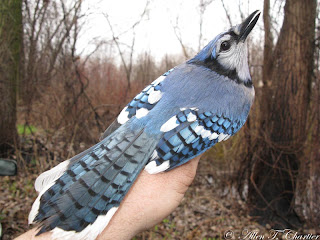Highlights of birds banded on Wednesday, April 27 included the season's first two Blue Jays.
 |
| ASY-U Blue Jay |
The majority of Blue Jays captured at our site are hatch-year birds in fall, and second-year birds in spring. One of today's' birds was an afte second-year, told by the barring on its primary coverts and alula which are unbarred in younger birds.
 |
| Barred primary coverts and alula of ASY-U Blue Jay |
The season's first House Wren was right on schedule, if not a couple days late.
 |
| AHY-U House Wren |
Perhaps most interesting was the season's first Eastern Towhee, since we don't band one every year.
 |
| SY-M Eastern Towhee |
This bird presented an interesting challenge to age. Eye color is one criterion for aging the species, and this male clearly had a red eye, which should suggest and after second-year bird in the spring.
 |
| SY-M Eastern Towhee |
But the primary coverts were clearly worn and brown, contrasting with the secondary coverts which suggests the bird was a second-year. It also appeared that the innermost tertial was new, contrasting with the other tertials as well as the duller primaries and secondaries.
 |
| SY-M Eastern Towhee |
With this conflict of characters, I chose to favor the molt as most indicative of age rather than eye color, and called it a second-year.
Interesting birds observed but not banded were few, due to the rain, but included an American Woodcock calling briefly just before dawn, relatively late Brown Creeper and Golden-crowned Kinglet, and season firsts of Wood Thrush, Northenr Waterthrush, and Common Yellowthroat.
Highlights of birds banded on Saturday, April 30 included two Northern Flickers. Yes, the bird in the photo below is taking whacks at my knuckles!
 |
| ASY-M Northern (Yellow-shafted) Flicker |
This male showed primary coverts from three distinct molts, very clearly contrasting, which allowed him to be aged after second-year
 |
| Molt contrast in primary coverts of ASY-Male Northern Flicker |
After noting them in the banding area for more than a week, it was nice to finally catch a Blue-gray Gnatcatcher, a species that isn't banded here every year.
 |
| AHY-M Blue-gray Gnatcatcher |
Even nicer was the fact that it was a male, told by its bold black forehead and eyebrow. Most gnatcatchers I've banded have been hatch-years and'or females that have lacked this mark.
 |
| AHY-M Blue-gray Gnatcatcher |
Somewhat unexpected, as none had yet been heard singing in the marsh, was a Marsh Wren. Even more unusual is that this is only the third ever banded here in spring since 1989; the first two were banded just last spring. Perhaps the habitat is improving for them?
 |
| AHY-U Marsh Wren |
The first warbler of the spring season was, as perhaps expected, a Yellow-rumped Warbler.
 |
| SY-M Yellow-rumped Warbler |
And the second warbler was a Common Yellowthroat. But this one was already banded, by me at this locale, on May 7, 2007 as a second-year male.
 |
| ASY-M Common Yellowthroat |
Last week, four American Tree Sparrows were banded on April 23, which was the latest the species had ever been banded at Metro Beach. In keeping with the wintery conditions that just won't go away, today one of those birds was recaptured, making it the latest ever captured here and perhaps the latest ever in the park.
 |
| AHY-U American Tree Sparrow |
Interesting birds observed but not banded today included three calling Virginia Rails and one Sora, two somewhat late Winter Wrens, and increased numbers of Yellow Warblers.
Banding on these two days could not have been done without the help of dedicated volunteers. I especially want to thank Tom Schlack for coming out on both days, and salvaging the week from Mother Nature's bad intentions. Also thank you to David Boon and Jeremy Miller for making the best of a bad day on Wednesday.
============================
Banding Data
-------------------------------------
WEDNESDAY, April 27, 2011
Sunrise (E.S.T.): 5:34
Time Open (E.S.T.): 6:00
Time Closed (E.S.T.): 10:30 (rain forced early closure)
Hours Open: 2.50 (rain forced intermittent closures)
No. of Nets: 3.00-4.00
Net Hours: 9.00
Temperature (F): 57-64
Cloud Cover: 100%
Wind: SSE @ 1-3-5 mph
Barometer: 29.68-29.47
Precipitation: Intermittent Rain
No. Banded: 10 (plus 1 recapture)
No. of Species: 6
Capture Rate: 122.2 birds per 100 net hours
Volunteers (worked 7.0 hours, 6:00-13:00): David Boon, Jeremy Miller, Tom Schlack
Downy Woodpecker - 1
Blue Jay - 2
House Wren - 1
Eastern Towhee - 1
White-throated Sparrow - 3
Red-winged Blackbird - 2 (plus 1 recaptured)
-------------------------------------
SATURDAY, April 30, 2011
Sunrise (E.S.T.): 5:30
Time Open (E.S.T.): 6:00
Time Closed (E.S.T.): 12:45
Hours Open: 6.75
No. of Nets: 3.25-9.25
Net Hours: 58.938
Temperature (F): 37-55
Cloud Cover: Variable
Wind: ENE-SE @ 1-3-10 mph
Barometer: 30.20-30.39
Precipitation: None
No. Banded: 53 (plus 15 recaptures and 3 released unbanded)
No. of Species: 20
Capture Rate: 120.5 birds per 100 net hours
Volunteers (worked 10.0 hours, 6:00-16:00): Tom Schlack.
Downy Woodpecker - 2
Northern Flicker - 2
Black-capped Chickadee - 1
House Wren - 1
Marsh Wren - 1
Ruby-crowned Kinglet - 1
Blue-gray Gnatcatcher - 1
Hermit Thrush - 1
Ameridcan Robin - 2
European Starling - 1
Yellow-rumped Warbler - 1
[Common Yellowthroat - 1 recaptured]
[American Tree Sparrow - 1 recaptured]
Song Sparrow - 1 (plus 1 recaptured)
Swamp Sparrow - 15
White-throated Sparrow - 5 (plus 1 released unbanded)
[Northern Cardinal - 1 recaptured]
Red-winged Blackbird - 8 (plus 1 recaptured and 2 released unbanded)
Common Grackle - 2
American Goldfinch - 8 (plus 10 recaptured)



No comments:
Post a Comment